cruise control OLDSMOBILE SILHOUETTE 2003 Owners Manual
[x] Cancel search | Manufacturer: OLDSMOBILE, Model Year: 2003, Model line: SILHOUETTE, Model: OLDSMOBILE SILHOUETTE 2003Pages: 466, PDF Size: 21.55 MB
Page 167 of 466
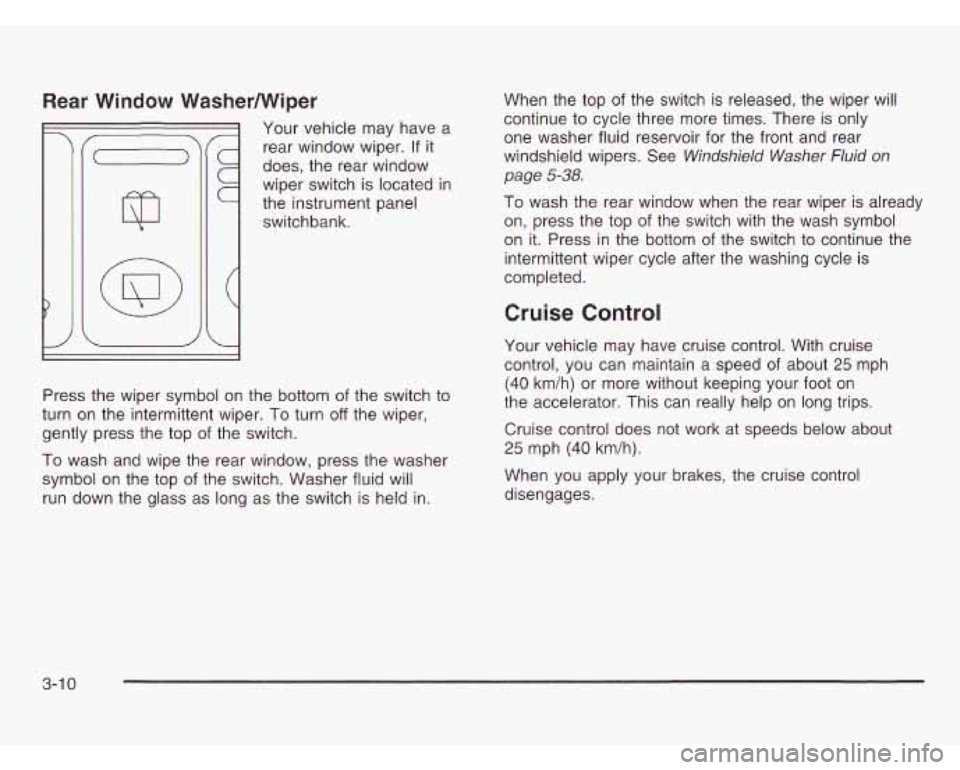
Rear Window WasherNViper
Your vehicle may have a
rear window wiper. If it
does, the rear window
wiper switch is located
in
the instrument panel
switchbank.
i
1
Press the wiper symbol on the bottom of the switch to
turn on the intermittent wiper.
To turn off the wiper,
gently press the top of the switch.
To wash and wipe the rear window, press the washer
symbol on the top of the switch. Washer fluid will
run down the glass as long as the switch is held in. When
the top
of the switch is released, the wiper will
continue to cycle three more times. There is only
one washer fluid reservoir for the front and rear
windshield wipers. See
Windshield Washer Fluid on
page
5-38.
To wash the rear window when the rear wiper is already
on, press the top
of the switch with the wash symbol
on it. Press in the bottom of the switch to continue the
intermittent wiper cycle after the washing cycle is
completed.
Cruise Control
Your vehicle may have cruise control. With cruise
control, you can maintain a speed of about
25 mph
(40 km/h) or more without keeping your foot on
the accelerator. This can really help on long trips.
Cruise control does not work at speeds below about
25 mph (40 km/h).
When you apply your brakes, the cruise control
disengages.
3-1 0
Page 168 of 466
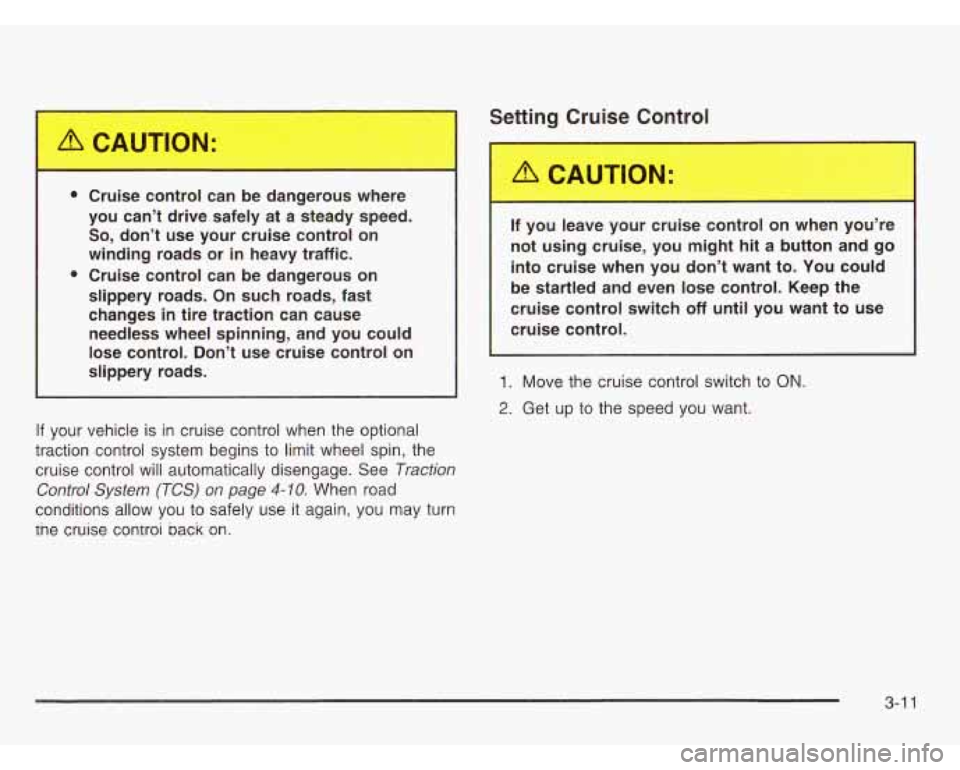
Cruise control can be dangerous where
you can’t drive safely
at a steady speed.
So, don’t use your cruise control on
winding roads or in heavy traffic.
Cruise control can be dangerous on
slippery roads. On such roads, fast
changes in
tire traction can cause
needless wheel spinning, and you could
lose control. Don’t use cruise control on
slippery roads.
If your vehicle is in cruise control when the optional
traction control system begins to limit wheel spin, the
cruise control will automatically disengage. See
Traction
Control System (TCS) on
page 4-10. When road
conditions allow you to safely use it again, you may turn
tne cruise controi back
on.
I ou leave your cruise control on when you’re
not using cruise, you might
hit a button and go
into cruise when you don’t want to. You could
be startled and even lose control. Keep the
cruise control switch
off until you want to use
cruise control.
1. Move the cruise control switch to ON.
2. Get up to the speed you want.
3-1 1
Page 169 of 466
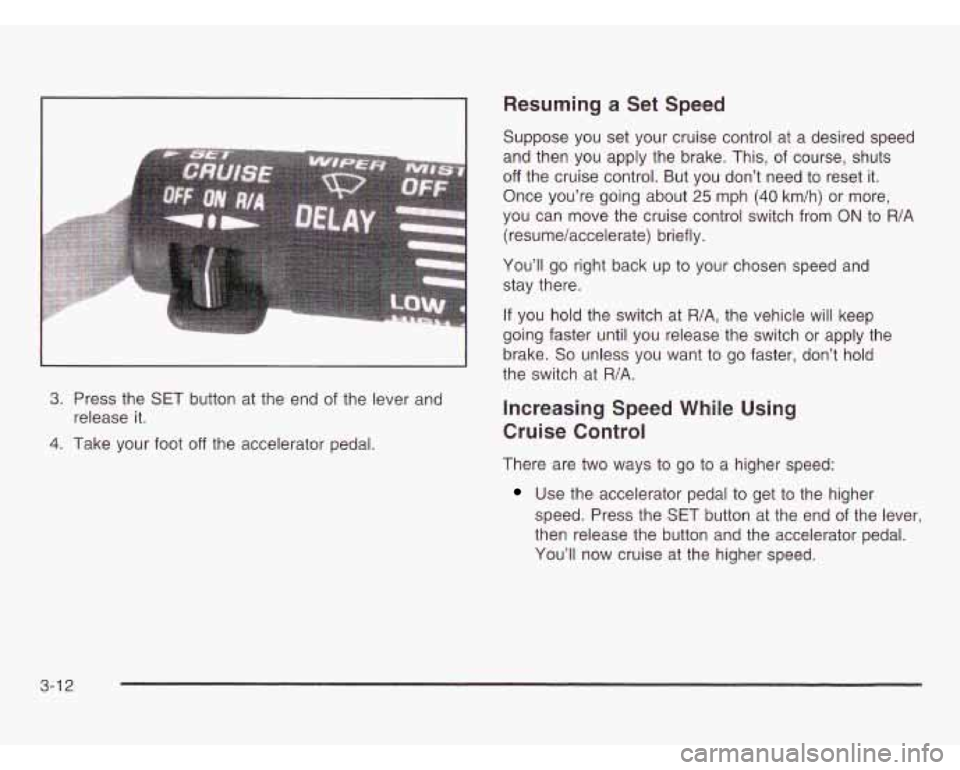
3. Press the SET button at the end of the lever and
4. Take your foot off the accelerator pedal.
release
it.
Resuming a Set Speed
Suppose you set your cruise control at a desired speed
and then you apply the brake. This, of course, shuts
off the cruise control. But you don’t need to reset it.
Once you’re going about
25 mph (40 km/h) or more,
you can move the cruise control switch from
ON to R/A
(resume/accelerate) briefly.
You’ll go right back up to your chosen speed and
stay there.
If you hold the switch at R/A, the vehicle will keep
going faster until you release the switch or apply the
brake.
So unless you want to go faster, don’t hold
the switch at R/A.
Increasing Speed While Using
Cruise Control
There are two ways to go to a higher speed:
Use the accelerator pedal to get to the higher
speed. Press the SET button at the end of the lever,
then release the button and the accelerator pedal.
You’ll now cruise at the higher speed.
3-1 2
Page 170 of 466
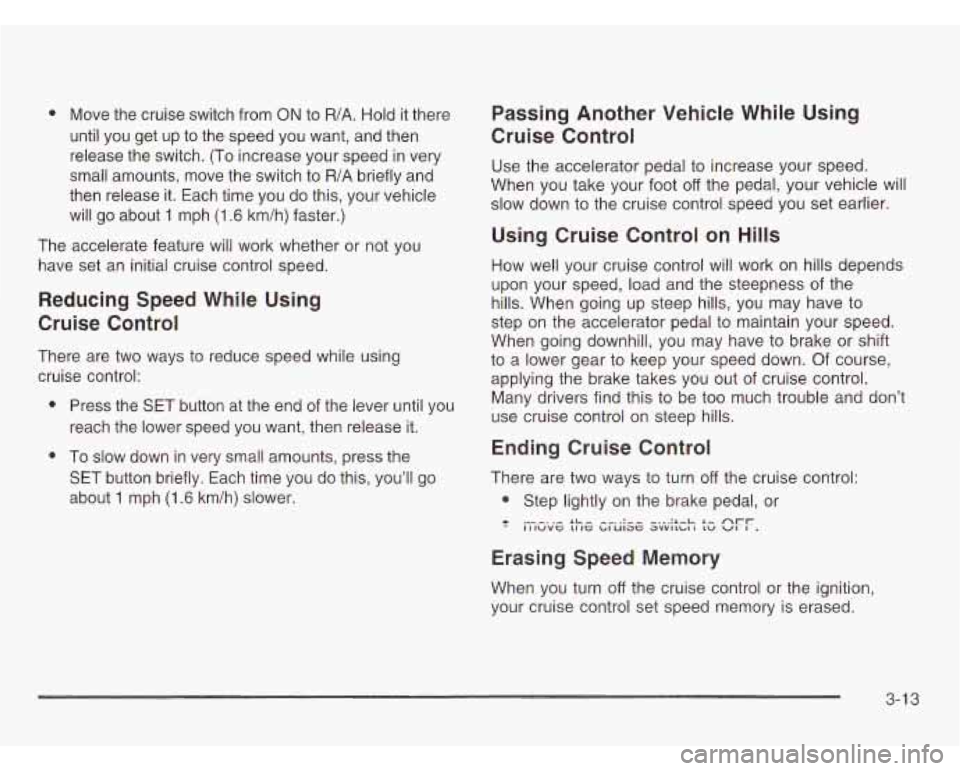
0 Move the cruise switch from ON to R/A. Hold it there
until you get up to the speed you want, and then
release the switch. (To increase your speed
in very
small amounts, move the switch to
R/A briefly and
then release it. Each time you do this, your vehicle
will go about 1 mph (1.6 km/h) faster.)
The accelerate feature will work whether or not you
have set an initial cruise control speed.
Reducing Speed While Using
Cruise Control
There are two ways to reduce speed while using
cruise control:
0 Press the SET button at the end of the lever until you
reach the lower speed you want, then release
it.
0 To slow down in very small amounts, press the
SET button briefly. Each time you do this, you’ll go
about 1 mph (1.6 km/h) slower.
Passing Another Vehicle While Using
Cruise Control
Use the accelerator pedal to increase your speed.
When you take your foot
off the pedal, your vehicle will
slow down to the cruise control speed you set earlier.
Using Cruise Control on Hills
How well your cruise control will work on hills depends
upon your speed, load and the steepness of the
hills. When going up steep hills, you may have to
step on the accelerator pedal to maintain your speed.
When going downhill, you may have to brake or shift
to a lower gear to keep your speed down. Of course,
applying the brake takes you out of cruise control.
Many drivers find this to be too much trouble and don’t
use cruise control on steep hills.
Ending Cruise Control
There are two ways to turn off the cruise control:
0 Step lightly on the brake pedal, or
- -. ,- LL- -.-. .:-- -... :L-L +- nrr IIIWVt 11 It bIUlDG DVVlLbl I LU VI I .
Erasing Speed Memory
When you turn off the cruise control or the ignition,
your cruise control set speed memory is erased.
3-1 3
Page 273 of 466
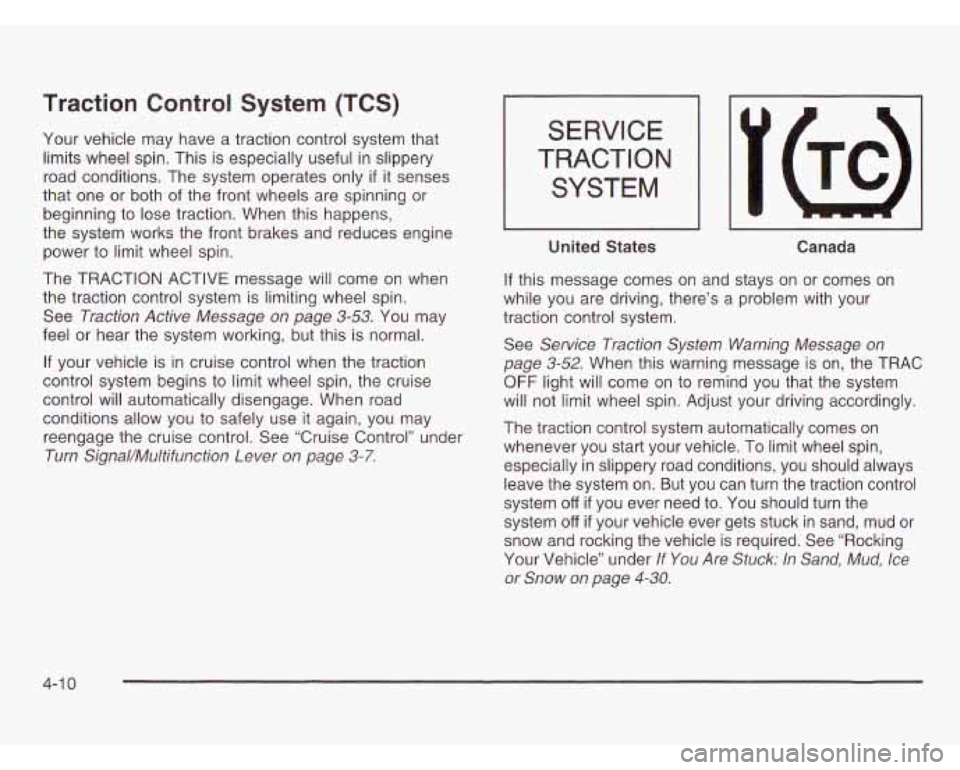
Traction Control System (TCS)
Your vehicle may have a traction control system that
limits wheel spin. This is especially useful
in slippery
road conditions. The system operates only
if it senses
that one or both of the front wheels are spinning or
beginning to lose traction. When this happens,
the system works the front brakes and reduces engine
power to limit wheel spin.
The TRACTION ACTIVE message will come on when
the traction control system is limiting wheel spin.
See
Traction Active Message on page 3-53. You may
feel or hear the system working, but this is normal.
If your vehicle is in cruise control when the traction
control system begins to limit wheel spin, the cruise
control will automatically disengage. When road
conditions allow you to safely use it again, you may
reengage the cruise control. See “Cruise Control’’ under
Turn SignaVMultifunction Lever on page 3-7.
SERVICE
TRACTION
SYSTEM
United States
Canada
If this message comes on and stays on or comes on
while you are driving, there’s
a problem with your
traction control system.
See
Service Traction System Warning Message on
page
3-52. When this warning message is on, the TRAC
OFF light will come on to remind you that the system
will not limit wheel spin. Adjust your driving accordingly.
The traction control system automatically comes on
whenever you start your vehicle.
To limit wheel spin,
especially in slippery road conditions, you should always
leave the system on. But you can turn the traction control
system
off if you ever need to. You should turn the
system
off if your vehicle ever gets stuck in sand, mud or
snow and rocking the vehicle is required. See “Rocking
Your Vehicle” under
If You Are Stuck: In Sand, Mud, Ice
or Snow on page
4-30.
4-1 0
Page 404 of 466
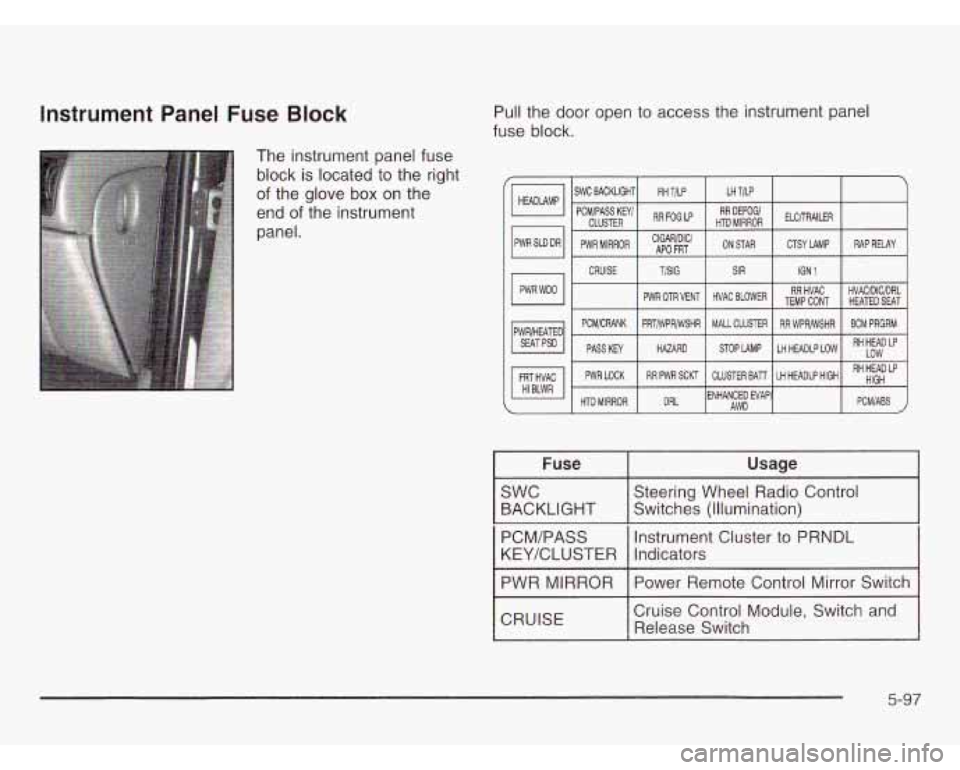
Instrument Panel Fuse Block
The instrument panel fuse
block is located to the right
of the glove box on the
end
of the instrument
panel. Pull the
door open
to access the instrument panel
fuse block.
PCWCRANK FRTMPWSHR MALL CLUSTER RR WPWSHR BCM PRGRM
Low RH HEAD LP
PASSKEY HAZARD STOPLAMP LHHEADLPLOW
I Fuse I Usage I
Steering Wheel Radio Control
I :!ZKLIGHT Switches (Illumination)
PCM/PASS Indicators
KEYKLUSTER Instrument Cluster to PRNDL
I PWR MIRROR I Power Remote
Control Mirror Switch I
I CRUISE I
Cruise Control Module, Switch and
Release Switch
5-97
Page 408 of 466
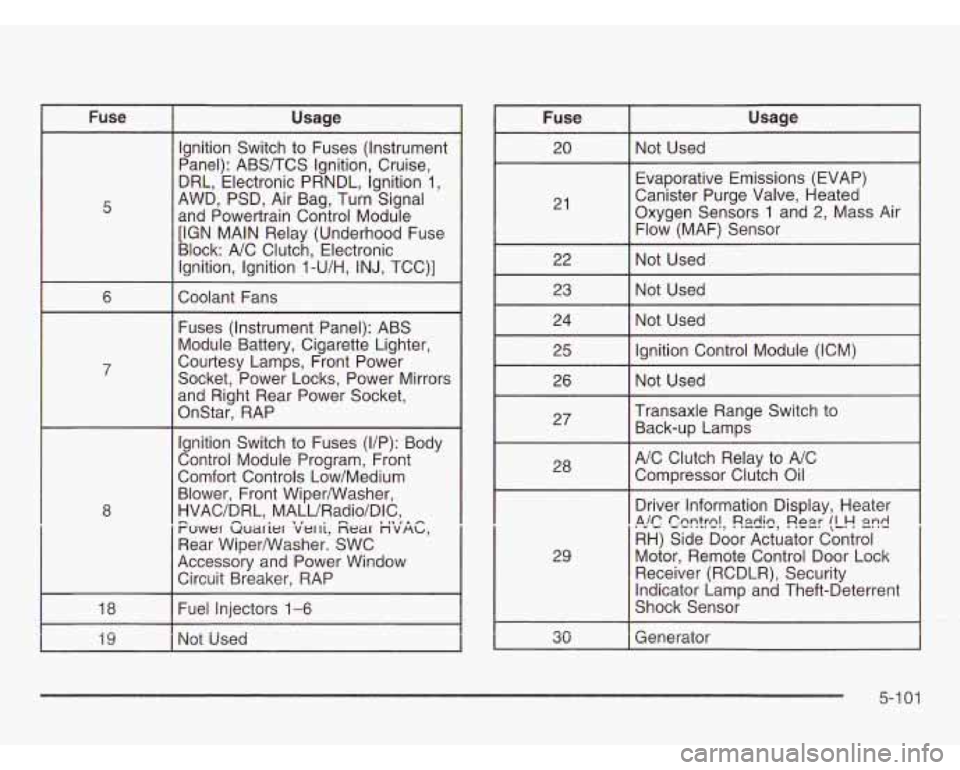
Fuse Usage
5 Ignition
Switch to Fuses (Instrument
Panel): ABS/TCS Ignition, Cruise,
DRL, Electronic PRNDL, Ignition 1,
AWD, PSD, Air Bag, Turn Signal
and Powertrain Control Module
[IGN MAIN Relay (Underhood Fuse
Block: A/C Clutch, Electronic
Ignition, Ignition
l-U/H, INJ, TCC)]
I 6 I Coolant Fans I
Fuses (Instrument Panel): ABS
Module Battery, Cigarette Lighter,
Courtesy Lamps, Front Power
Socket, Power Locks, Power Mirrors
and Right Rear Power Socket,
OnStar, RAP
Ignition Switch to Fuses (VP): Body
Control Module Program, Front
Comfort Controls Low/Medium
Blower, Front WiperANasher,
HVAC/DRL, MALURadio/DIC,
Puwer Guarier iierri, Zear nvnb,
Rear Wiper/Washer. SWC
Accessory and Power Window Circuit Breaker, RAP
I I. ,n -
I 18 I Fuel Injectors 1-6 I
Fuse Usage
21 Evaporative Emissions (EVAP)
Canister Purge Valve, Heated
Oxygen Sensors 1 and 2, Mass Air
Flow (MAF) Sensor
I 22 I Not Used I
23 I Not Used
I 24 I Not Used I
I 25 I Ignition Control Module (ICM) I
I
26 I Not Used I
I 27 I
Transaxle Range Switch to
Back-up Lamps
I 28 I
A/C Clutch Relay to A/C
Compressor Clutch Oil
29
I I’ *ulc CQr?!!3!, !?.ldiQ, Re2r !L!-! 2nd , I
Driver Information Display, Heater
RH) Side Door Actuator Control
Motor, Remote Control Door Lock
Receiver (RCDLR), Security
Indicator Lamp and Theft-Deterrent
Shock Sensor
5-1
01
Page 428 of 466
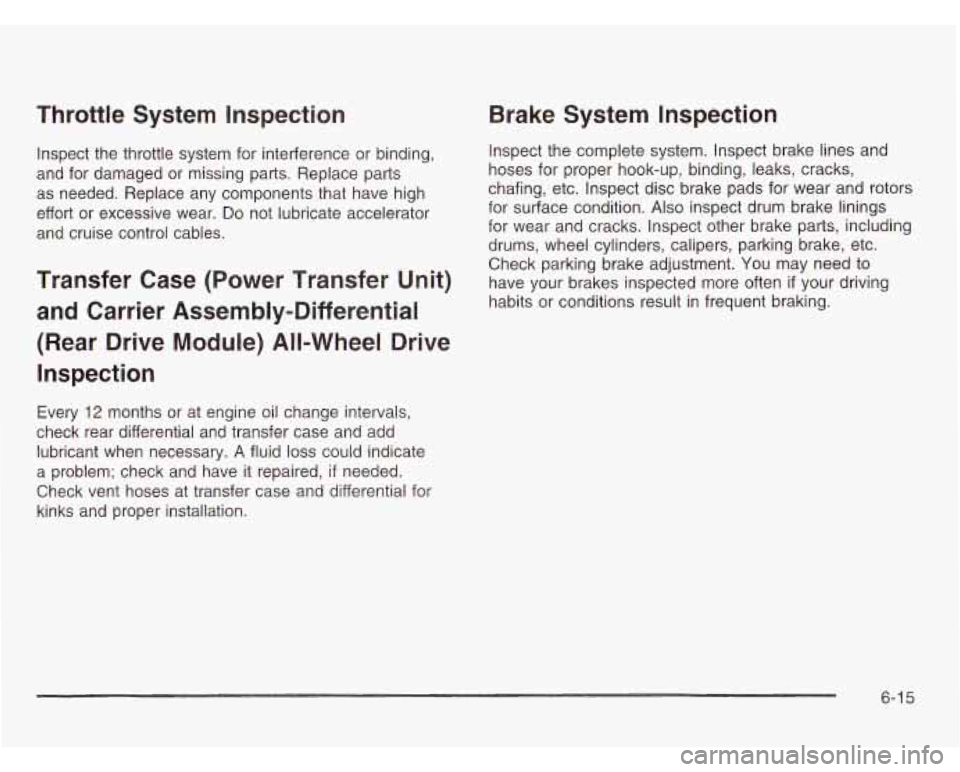
Throttle System Inspection
Inspect the throttle system for interference or binding,
and for damaged or missing parts. Replace parts
as needed. Replace any components that have high
effort or excessive wear.
Do not lubricate accelerator
and cruise control cables.
Transfer Case (Power Transfer Unit)
and Carrier Assembly-Differential
(Rear Drive Module) All-Wheel Drive
Inspection
Every 12 months or at engine oil change intervals,
check rear differential and transfer case and add
lubricant when necessary.
A fluid loss could indicate
a problem; check and have it repaired,
if needed.
Check vent hoses at transfer case and differential for
kinks and proper installation.
Brake System Inspection
Inspect the complete system. Inspect brake lines and
hoses for proper hook-up, binding, leaks, cracks,
chafing, etc. Inspect disc brake pads for wear and rotors
for surface condition.
Also inspect drum brake linings
for wear and cracks. Inspect other brake parts, including
drums, wheel cylinders, calipers, parking brake, etc.
Check parking brake adjustment.
You may need to
have your brakes inspected more often
if your driving
habits or conditions result in frequent braking.
6-1 5
Page 449 of 466
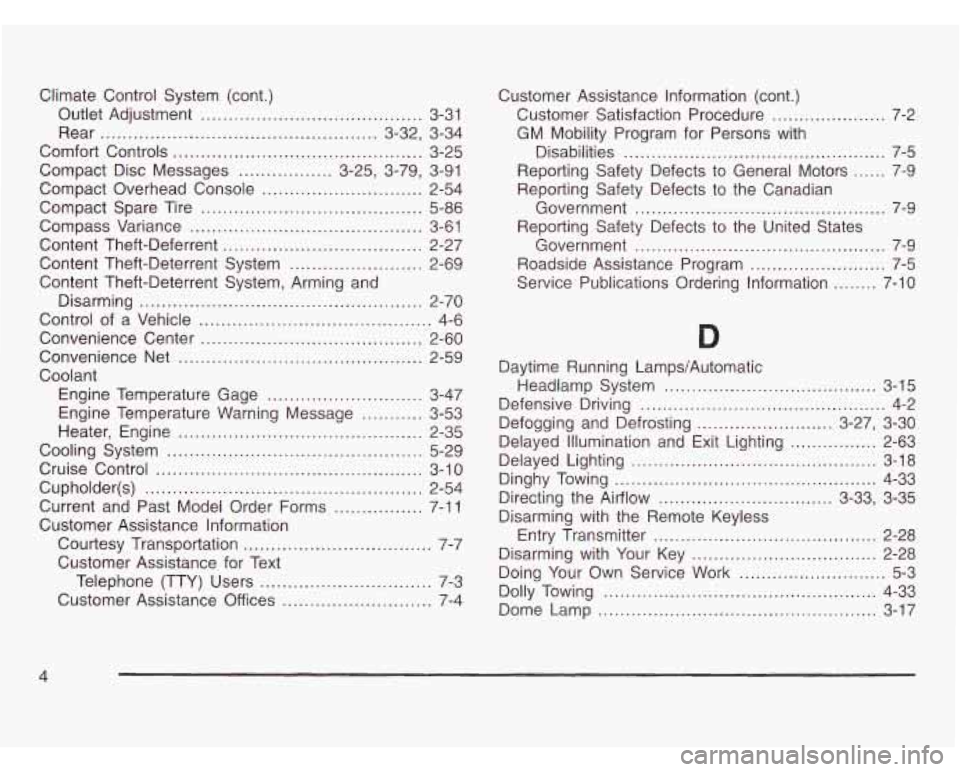
Climate Control System (cont.)
Outlet Adjustment
.................................... 3-31
Rear
.................................................. 3-32, 3-34
Comfort Controls
............................................. 3-25
Compact Disc Messages
................. 3-25, 3-79, 3-91
Compact Overhead Console
............................. 2-54
Compact Spare Tire
........................................ 5-86
Compass Variance
.......................................... 3-61
Content Theft-Deferrent
.................................... 2-27
Content Theft-Deterrent System
........................ 2-69
Content Theft-Deterrent System, Arming and
Disarming
................................................... 2-70
Control of a Vehicle
.......................................... 4-6
Convenience Center
........................................ 2-60
Convenience Net
............................................ 2-59
Coolant Engine Temperature Gage
............................ 3-47
Engine Temperature Warning Message
........... 3-53
Heater, Engine
............................................ 2-35
Cooling System
.............................................. 5-29
Cruise Control
................................................ 3-1 0
Cupholder(s) .................................................. 2-54
Current and Past Model Order Forms
................ 7-1 1
Customer Assistance Information
Courtesy Transportation
.................................. 7-7
Customer Assistance for Text
Telephone (TTY) Users
............................... 7-3
Customer Assistance Offices
........................... 7-4 Customer
Assistance Information (cont.)
Customer Satisfaction Procedure
..................... 7-2
GM Mobility Program for Persons with
Disabilities
................................................ 7-5
Reporting Safety Defects to General Motors
...... 7-9
Reporting Safety Defects to the Canadian
Government
.............................................. 7-9
Reporting Safety Defects to the United States
Government
.............................................. 7-9
Roadside Assistance Program
......................... 7-5
Service Publications Ordering Information ........ 7-10
Daytime Running Lamps/Automatic
Headlamp System
....................................... 3-15
Defensive Driving
............................................. 4-2
Defogging and Defrosting
......................... 3-27, 3-30
Delayed Lighting
............................................. 3-18
Delayed
Illumination and Exit Lighting
................ 2-63
Dinghy Towing
................................................ 4-33
Directing the Airflow
................................ 3-33, 3-35
Disarming with the Remote Keyless
Disarming with Your Key
.................................. 2-28
Doing Your Own Service Work
........................... 5-3
Dolly Towing
.................................................. 4-33
Dome Lamp
................................................... 3-17
Entry Transmitter
..................................... 2-28
4